#a matriarch and a source of trauma
Text
The Aid Masterlist
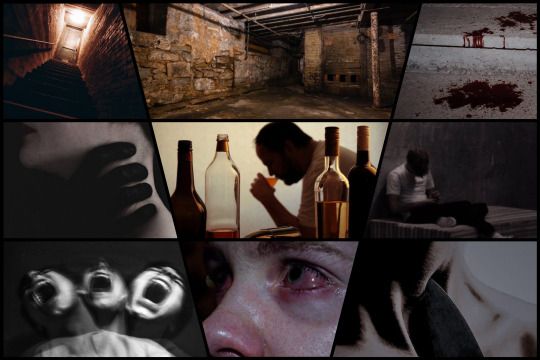

Cover pics sourced from Pinterest
(18+, MINORS DNI!)
Bad summary (I suck at these): Set in the near future, an ability wielding telepathic-empathic 18-year-old sells himself into high-class slavery to support his family and to escape the wrath of an impeding Regime that has overthrown the US government, as well as avoid the growing numbers of the ravenous blood-thirsty hoards of afflicted. Stripped of his name, The Aid serves under a Southern Californian socialite, Madame Eleanor, the prestigious Sullivan family matriarch, for five years before being given to her Sadistic Son, Wyatt, after her untimely death. He now must fight for survival in a war-torn world and rediscover who he is, and hopefully, he’ll make a friend or two along the way.
What you can expect: A long, slow-burn type story with undertones of family war-time drama, multiple POVs (in the works), multiple parts, and Whumping of all kinds. Too many themes and lots of insane shit. This story is the first of many in my chaotically crafted BBU-inspired original AU (although it is very different). It’s a bit of a mess rn, I’m figuring it out as I go along and it’ll all tie in and make sense eventually. And oops this may turn into a “multiple book” situation. Oh I’m sorry, you wanted a simple whump story? Too bad, take a never-ending series instead!
General vibes: post-apocalypse desert horror meets torture den meets psychedelic 60s and mid-centruy modern aesthetics (plus a lot more other shit that will come in wayyyyy down the road).
General content warnings:
This is a heavier story with little to no comfort and constant levels of hurt (physical and emotional), including NSFW themes, heed any TWs & CWs listed at the beginning of each part! This is not a happy story (at least right now and in the near future, but he will have a happy-ish ending I promise), if you want something nice n’ fluffy, this isn't it!
*Not all of these themes are explored yet, but they will be. I’m trying not to give away spoilers while also being upfront by what to expect here.
20+ year age gap between Whumpee & Whumper
Former (elderly) lady Whumper (dies at 73)
Institutionalized slavery in a post-war/ post-apocalyptic AU
Culty & conspiratorial religious extremism (not the main focus of this story, but it’s there in the background and connected to above bullet point)
Cannibalism (the “afflicted” are basically stand-ins for zombies)
Non-con & dub-con (varying degrees of each, anything explicit will be marked as such!)
Red room whumping (working up to it, this feels like a spoiler)
Addiction & substance abuse + general use & mentions (prescription & illicit drugs, alcohol, gambling, porn), + noncon drugging
Caretaker turned Whumpee (“Caretaker” as in literal caregiver)
Sadistic/creepy/intimate/verbally and mentally abusive Whumper
Death threats, attempted murder, and murder
Discussions of mental health including suicidal ideation
Multiple Whumpers (& eventually multiple Whumpees— wow this also feels like a spoiler)
Long-term captivity, and conditioning— I’m talking 5 + 4ish more years (but this does not mean the MC is completely helpless and always compliant and doesn’t snap back!)
Medical & lab whump (this is probably more medical malpractice and just bad healthcare, but there’s some experimental drugging!)
Starvation & subsequent issues with food
Manipulation/ emotional whump
Defiant & angsty Whumpee(s)
Paranormal encounters
Family trauma & drama
Idk what to call this, but MC has some special abilities but it’s not necessarily magic. I wouldn’t consider this magic or fantasy whump by any means and the story does not revolve exclusively around this, although it plays a personal part for MC.

The lists below will be continuously updated when I have new stuff to add! I know it ain't much yet, but I'm workin' on it! :)
Part 1: Out from Under
Prologue (Meet The Whumper)
Chapter 1: Pump It (Louder!)
Chapter 2: Belligerance
Chapter 3: Say My Name
Chapter 4: One Step Closer
Chapter 5: Part 1, Part 2
Chapter 6: Stranger to Myself
(NSFW)Chapter 7: Sicko Fantasies & Haunting Memories
Polls:
Pick a sleep paralysis entity/being to haunt The Aid!
Art:
Bad Procreate Portrait! +Backstory
Lashings
Basement Dayz
Other:
"Life Before" Backstory ask
OC in 3 (Aid vibe pics, visual references)

#The Aid masterlist#the aid#whump writing#oc whump#oc whump fic#oc fic#whump blog#whump fic#whump story#whump masterlist#Wyatt Sullivan#caretaker turned whumpee#noncon whump#tw noncon#whumpee x whumper#alcoholic whumper#tw alcohol#tw alchoholism#creepy whumper#intimate whumper
42 notes
·
View notes
Text
“…Alyson Miller proposes that Adora is “a wicked source, the product […] of a conflicted maternal heritage.” Through this child killer, Flynn’s novel also present the case of an “internalization of the regulatory practices of patriarchy” where Amma’s monstrosity is an “extreme version” of a “patriarchal logic that seeks to annihiliate […] the presence of the ‘other’.” Amma, as part of an “ancestry of monstrous women” and a “biological destiny of evil” represents an “iteration of the dominant culture.” That is, the murders that Amma commits can be viewed through the lens of misogynistic violence, as they involve not only torturing and killing girls but also silencing them (taking out their teeth and keeping them as trophies) and discarding their bodies. Amma’s motive for committing these horrific murders is jealousy; she was jealous of the attention that her mother was giving to these girls, but it is also clear that the abuse that Amma endured under her mother’s hand has turned rage into violence. Amma thus turns into a ruthless killer and becomes obsessed with killing.”
“The dollhouse itself becomes more than a child’s game to Amma. It is the site of violence, a site of the trophies for her murders. The dollhouse, an exact replica of the Crellin household… holds the secrets of family suffering and trauma… The dollhouse shows the child in Amma, yet it also reveals a dark and malevolent side of the thirteen-year-old girl that mirrors her mother’s monstrosity.”
“The symbolism of dolls that runs throughout the narrative confirms the pathology that dictates female characterization in the book. It is not merely associated with Amma, but the image of Adora as a “doll” is constantly invoked in the story. The motif of dolls is indicative of the construction of femininity in this narrative on the one hand, and the friction between motherhood and childhood on the other. Adora, the mother, is presented as girlish, even childish, in the way she dresses and acts…The reference to Adora in terms of a doll infantilizes her and highlights her obsession with children; she loves her image as a perfect lady and hostess, but more than anything, she is obsessed with her role as a mother… this image of Adora as a doll also stand parallel to Amma’s obsession with the dollhouse, which is ultimately tied to criminality.”
“…both Adora and Amma are responsible for killing young girls. By the end of the book, it is confirmed that the presence of Adora as a pathological mother is ubiquitous. When the mystery of the two murdered girls is resolved, fingers are pointed not just at Amma but also at her mother as the reason behind the thirteen-year-old’s criminal behavior. The ending brings the two narratives of the dead girl and the monstrous mother together by situating the frightening matriarch against her murderous daughter. By doing so, Flynn challenges the stereotypes of women by creating female characters, a mother, and a daughter, who “slip in between the regulations of a binary in which women are identified as virgins or whores” and “subvert the conventions of feminine social codes.””
“In a revealing monologue, Amy talks about the “cool girl, a construction that appeals to men and one that relies on emphasized feminity.5” 5 Emphasized femininity…is a pattern of femininity that is defined according to women’s “compliance and subordination,” it is “oriented to accommodating the interests and desires of men.” Emphasized femininity highlights how women contribute to their own victimization and marginalization in a patriarchal hierarchy. The notion of emphasized femininity thus brings about gender roles that rely on loving nurturing mothers and domestic women.”
“… the missing victimized or missing woman, a paradigmatic voice of sorts into which anything can be, and frequently is, projected […] she [Amy] is unable to escape the often stifling symbolic confines of femininity in spite of her own machinations.”
“Gillian Flynn’s Sharp Objects and Gone Girl succeed in destabilizing the links between femininity and victimhood by present women like Adora and Amy who undermine the image of the good wife/mother. By doing so, Flynn’s thrillers challenge the societal roles of “serving an image, authoritative and central, of man: a woman is first and foremost a daughter/a mother/a wife.” By confusing and sometimes conflating the roles of the victim/criminal, Flynn’s two novels undermine and destabilize the certainty and urgency around the constructions of the female criminal.”
“The two competing narratives of the dead girl and the malevolent mother, told through the medium of a thriller, establish parallel narratives of the conjunction between female crime and trauma, and between femininity and violence. Trauma is central to the female characterization and these narratives; it is tied to the female body and “the atrocity exhibition” of broken bodies and violence at the heart of Flynn’s novels. In Sharp Objects, the trauma the sisters encounter at the hand of their mother dictates not only the plot and the mystery of the dead girls, but it is key to the resolution of the murders when the perpetrator (Amma) is revealed… Ultimately, Flynn’s thrillers paint an intriguing dark picture of femininities with contrasting manifestations of victimhood against agency where traumatized females are set against vengeful ones and missing/dead females are positioned against murderous ones.”
-From, Monstrous Mothers and Dead Girls in Gillian Flynn’s Sharp Objects and Gone Girl by Maysaa Jaber [Part 3]
#sharp objects#camille preaker#amma crellin#adora crellin#this is the last one for this essay I promise.
44 notes
·
View notes
Text
Why is it when people suggest you find meaning, you go to
- the faith of an imagined sky god
- the positivity of light and love
- the science of material
- the discussions of philosophy
- the history of man-kind
- the shadows of our traumas
- the intelligence of the mind
- the politics, economy, socialization of our community
- the
But never the source of life itself, Mother Nature? Her elements, her consciousness, her story, her tried and true life force? It’s the one and only constant we have in this universe. (I include her as the universe). Why do people suggest breaking her down into products of the above than go straight to her source of insight?
And why do people never go to her creations, our bodies, as the ultimate source of meaning?
People love to split and dissociate the roots of everything that exist but never study the roots themselves.
I wonder what they are so scared of finding that they need to deviate from it?
I for one, plan to dive deep into it as possible.
- Laura Rose
Returning to Her
#patriarchy#radical feminism#divine female#anti patriarchy#mother nature#radfem#womensrights#womenempowerment#radical feminist#women power#matriarchy#return to matriarchy#returning to her#healingfromharm#Mother Earth#divine power#spirituality#science
12 notes
·
View notes
Text

The Millennium Saga Book Three: Goddess-Touched - a formal WIP intro
This is book three of the Millennium Saga! Intros for the first two can be found here: Firebreathers [x] and Echoseers [x].
The waves of the harbor glitter dark in the moonslight, still and quiet. A hum of something that tickles the edge between hearing and feeling thrums through the air, a constant warning. A threat.
I am not alone on the dock where I sit. A pair of wide, void-like eyes gazes up at me from the sallow face just beneath the water’s surface, watching. Waiting. Curiosity of a form alien and uncomfortable to that I’ve always known clouds their eyes like cataracts.
Shadows drip from the underside of my cloak, spilling onto the wood and mixing with the sea. Coating everything they touch with a thick layer of tar, and a thicker layer of intrigue to draw the creature closer.
It is not the first time I’ve met them here, and I know it won’t be the last.
Genre: High fantasy/Steampunk
Target Audience: New Adult/Adult
POV: First person present, Multi-POV
Themes: Anti-Imperialism, trauma and recovery, hope and hopelessness, the stigma surrounding mental illness, the differences between vengeance, atonement, and justice, the separation between faith, religion, and deities, death and life and which one defines humanity more, the effects of leaving the only home you’ve known behind, and the struggle to rebuild after disaster.
Currently drafting at about 16k words.

The ocean has run red.
Three months past, and still none dare to touch the sea where countless ships have been ripped apart by the legends only now rising from the depths. Still none dare to get too close to the blackening scar of Delya, where a hundred thousand souls have yet to find peace. Still none dare to acknowledge the empty dais where the Chosen once stood.
And still none dare to tell the world what happened.
The Archer cannot return home as the waves threaten to swallow them whole. The Wiremaster refuses to even think of it, once he sees the beauty of the desert. The Acrobat still can’t find his balance, and the Artist must face his own impermanence.
The Starsmith races to find a solution to the world’s isolation. The Survivor seeks answers from even the most dangerous of sources. The Detective alone remains in Impalfahr, and alone has the power to tell the world just how little time is left.
The King has disappeared. The Knight is broken. The Matriarch must watch her world crumble again.
The Fourth Eternal is risen.
The ocean has run red.
The ocean has run red, and the Deepfolk will never let the Goddesses forget their part in destruction.
The Millennium Saga Taglist is maintained below the cut here and on the intro for Echoseers!
Ask to be added or removed:
@ladywithalamp ; @lavenderrosewrites ; @47crayons ; @writeblrfantasy ; @ashen-crest ; @dragon-swords-prophecies ; @faithfire ; @midnight-and-his-melodiverse ; @lexiklecksi ; @writingrosesonneptune ; @ren-c-leyn ; @doriians
#I ONCE AGAIN APOLOGIZE IF THE EDIT TO THE POST TAGS Y'ALL ON THE LIST#writeblr#writblr#writers on tumblr#fantasy fiction#original fiction#original writing#wip intro#the millennium saga#goddess touched#edit: added the update on drafting progress and the taglist!
90 notes
·
View notes
Text

Kimowan Metchewais, “Cold Lake Fishing”, 2004/06

Koyoltzintli, “Gathering Roots” and “Spider Woman Embrace”, Abiquiú, New Mexico, 2019, from the series MEDA, 2018/19, Archival pigment print
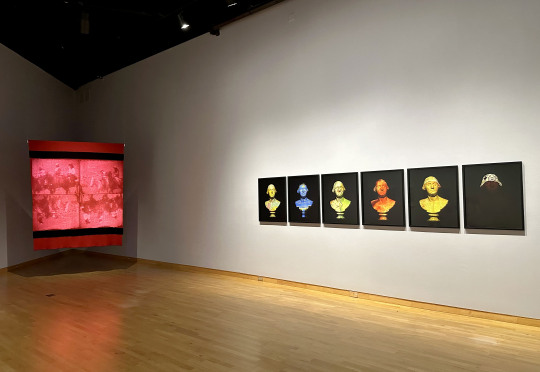
(Alan Michelson “Hanödagayas (Town Destroyer): Whirlwind Series”, 2022 Archival pigment prints and “Pehin Hanska ktepi (They Killed Long Hair)”, 2021 Single-channel video installation: wool blanket and video projection; 1:05 minutes (looped), no sound)
Currently at the USF Contemporary Art Museum is Native America: In Translation curated by Wendy Red Star and organized by Aperture. The work included offers viewers a chance to discover new perspectives on the Native American experience.
From the museum-
“The ultimate form of decolonization is through how Native languages form a view of the world. These artists provide sharp perceptions, rooted in their cultures.” —Wendy Red Star
Native America: In Translation assembles the wide-ranging work of nine Indigenous artists who pose challenging questions about identity and heritage, land rights, and histories of colonialism. Probing the legacies of settler colonialism, and photography’s complex and often fraught role in constructing representation of Native cultures, the exhibition includes works by lens-based artists offering new perspectives on Indigenous identity, reimagining what it means to be a citizen in North America today.
Works included in the exhibition address cultural and visual sovereignty by reclaiming Native American identity and representation. Honoring ancestral traditions and stories tied to the land, Koyoltzintli (Ecuadorian-American, b. 1983) reflects on how the landscape embodies traditional knowledge, language, and memories. Nalikutaar Jacqueline Cleveland’s (Yup’ik, b. 1979) photographs of contemporary tribal communities in western Alaska document Native foraging and cultural traditions as a form of knowledge passed through generations. Revealing stories of trauma and healing, Guadalupe Maravilla (American, b. El Salvador, 1976) communicates autobiographical and fictional narratives informed by myth and his own migration story.
Expanding Indigenous archives and collective memory through photographic means, works by the late artist Kimowan Metchewais (Cree, Cold Lake First Nations, 1963–2011), drawn from his personal archive of Polaroid photographs, construct self-realized Native imagery challenging the authority of colonial representation. Excavating repressed colonial histories of invasion and eviction, Alan Michelson (Mohawk, Six Nations of the Grand River, b. 1953) reinterprets and repositions archival material to redress history from an Indigenous perspective. Marianne Nicolson’s (Musgamakw Dzawada’enuxw First Nations, b. 1969) light-based installation projects Dzawada’enuxw tribal symbols of authority and power onto colonized spaces to contest treaties that imposed territorial boundaries on Indigenous lands. Duane Linklater (Omaskêko Ininiwak from Moose Cree First Nation, b. 1976) reconfigured the pages sourced from a 1995 issue of Aperture, featuring Indigenous artists, creating space for artistic improvisation and reinvention across generations.
Reflecting on performative aspects of Indigeneity and the colonial gaze, Martine Gutierrez’s (American, b. 1989) series of photographs reinterpret high-fashion magazine spreads with a revolving roster of identities and narratives to question Native gender and heritage. Working across performance and photography, Rebecca Belmore (Anishinaabe, Lac Seul First Nation, b. 1960) creates powerful reenactments of past performances incorporating organic materials that reference knowledge, labor, and care of the Earth in defiance of state violence of Indigenous people.
This exhibition closes 12/1/23.

Rebecca Belmore, “matriarch”, 2018, and “mother” from the series “nindinawemaganidog (all of my relations)”, 2018, Archival pigment prints

Photos by Rebecca Belmore and Installation by Marianne Nicolson
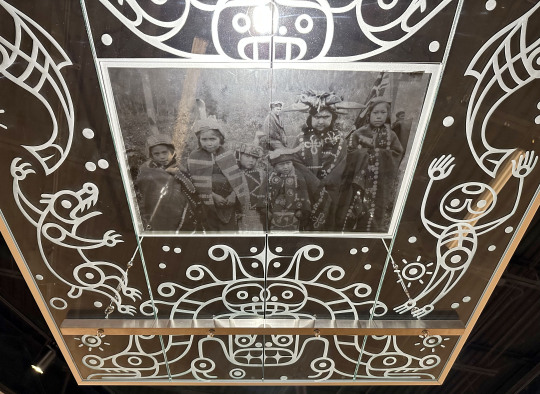

Marianne Nicolson’s installation detail
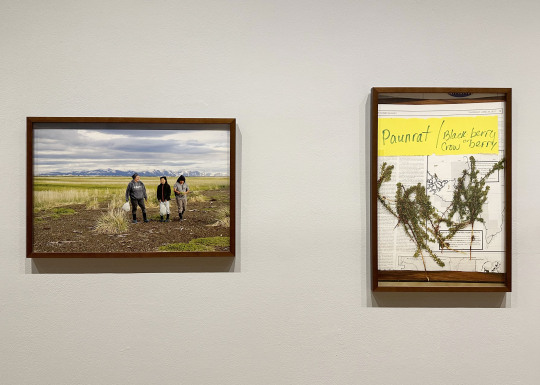
Nalikutaar Jacqueline Cleveland, “Molly Alexie and her children after a harvest of beach greens in Quinhagak, Alaska”, 2018 and “There are two main Yup’ ik names for crowberries or blackberries in Alaska, “paunrat” and “tangerpiit””, 2017, Archival pigment prints

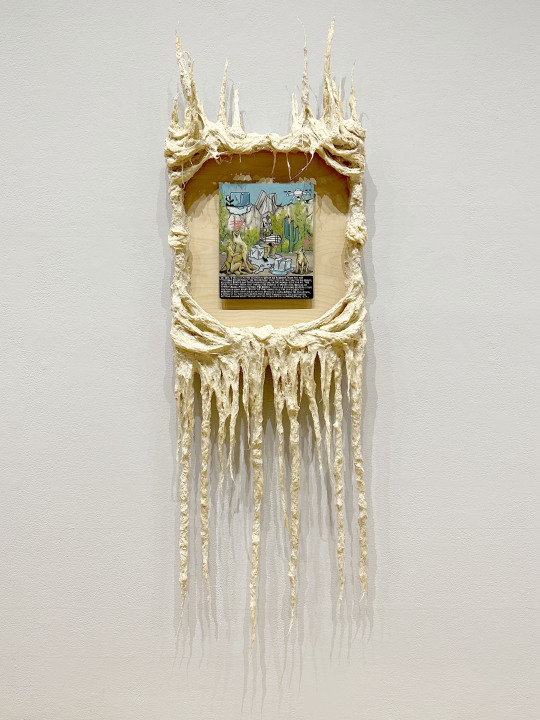
Guadalupe Maravilla, “I Crossed the Border Retablo”, 2021, Oil on tin, cotton, glue mixture, wood
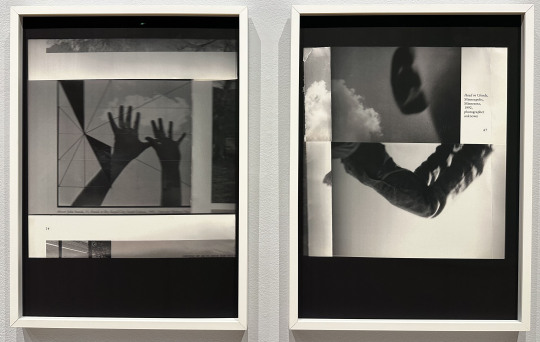

Duane Linklater, “ghost in the machine”, 2021, Archival pigment prints
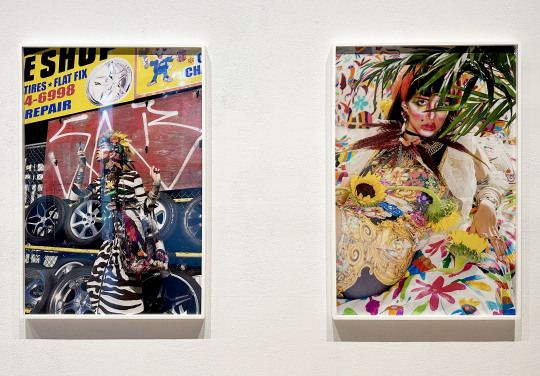
Martine Gutierrez, “Queer Rage, Dear Diary, No Signal During VH1’s Fiercest Divas”, and “Queer Rage, THat Girl Was Me, Now She’s A Somebody”, 2018. digital chromogenic print

One of Kimowan Metchewais’ polaroids from the slide show
#USF Contemporary Art Museum#Native American Artists#Rebecca Belmore#Kimowan Metchewais#Alan Michelson#Martine Gutierrez#Institute For Research in Art#Marianne Nicolson#Duane Linklater#Koyoltzintli#Guadalupe Maravilla#Nalikutaar Jacqueline Cleveland#Mixed Media#Mixed Media Art#Art#Mixed Media Photography#Native American#Native American Art#Native American Heritage Month#Black and White Photography#Art Shows#Florida Art Shows#Native American History#Photography#Polaroid#Polaroid Photography#Tampa Art Shows
3 notes
·
View notes
Note
Hi!
4, 10 and 16 for the writer's ask game please
4, When did you start writing? How?
December 2011. One keystroke at a time on a Thinkpad that overheated. One of my first stories was a dragon academia fantasy, where students underwent a trial to determine what elemental dragon they could shapeshift into and that split the grade group to their respective packs. There is no surviving copy of that project.
I do remember that in late 2012 or in 2013, I had another original project that took place in Alice in Wonderland if such place was a prison with experimentation gone wrong, and there was a prison break. Again, no surviving copies of that project. Got me first unsolicited anonymous critiques regarding it, and it might be why I just write fanfic nowadays and pour all my creative passion into that.
10, Character/WIP Lore! (blabber about character/ WIP of choice)
Nah, I don't want to. Because I've started drafting, it's easier to just get work done and do what I want to do for the story without extraneous pressure from setting expectations so early for people when I answer questions like this.
16, Who is your most traumatized character? What happened to them?
Being a fanfic writer, it depends on the source material. It's a toss up between Dream of the Endless and Vash the Stampede. I'm going to lean towards Vash because he's closer - both in time and emotional investment - to his trauma and feels obligated to right his wrongs and make the world a better place.
If we're talking about original characters, I had one from 2018 named Diana Petrova. Single mom with a toddler, raised from a strict matriarchal family, not on speaking terms with her mother, lost her husband to a shoot out when he showed up at the wrong place at the wrong time by her mother's suggestion, and inherited a crime militia that's passed down from one woman to another in her family and she wants nothing to do with it and just wants to be a regular mom. But what gives Diana some closure is that she is the last woman in her family line, meaning her son will have the freedom she never had as a child, and will grow up without knowing so much about murder, guns, and turf wars. And she's adamant to take down the crime militia along with her family name to spend those happier, calmer tomorrows with her boy.
Writer Ask Thingies
4 notes
·
View notes
Text
DWC Day 1: Instinct - Neglect
Before and After
[CW: VIOLENCE, BLOOD]
"I never was much of a gambler, in the manner of games, my stakes are much higher; creating the life I crave for myself with each calculated risk."
In the months that followed Valanthriell's last call to action, a rapid succession of change reached every avenue in this entrepreneur's world, a show of her hand acting as a gag order on any vicious retaliation from the Usurper of her family seat.
The Matriarch of the Shadowfel family, Amalie, had gifted her townhouse in Dalaran to Valanthriell's cause, giving a proper home for her great-grandchild and themselves away from Fealia's twisted control. With all the chaos and drastic changes in Valanthriell's daughter, Taaliah's life, a decision was made to hire help in the form of a Nanny and Child Psychologist to ease her through the disruptions. The abuses suffered by the child at the hands of her so-called grandmother were thankfully not of the physical variety but equally cruel, a child ignored by even the staff by order of the Mistress of the house, the only caring hand was that of GreatMama Amalie, who acted as an anchor for the child during the new upheaval.
Now every part of Valanthriell's world was thriving, in business and in the family there was expansive growth and a child experiencing bliss for the first time in her young life.
Taaliah had shown curiosity for the piano and Valanthriell would fund and fuel even the whim of any interest, the keys plunked slowly as the child practiced, speaking the letters of each note as she happily played. Their bond was still forming, but after living so long believing her mother was dead Taaliah was overjoyed to have a family that cared let alone her mother and she reached for the love without trepidation, bringing joy to Valanthriell's heart.
"Might I join you Little Dove?" Valanthriell asked softly as to not startle the child.
Taaliah hummed for a moment as if weighing the decision, a carbon copy of her mother. "I suppose that would be agreeable." Taaliah giggled, scooting over to allow enough room for them both on the piano stool.
Valanthriell gently played a song from her childhood, a shining memory in the haze of trauma, a song taught by her Nanny so long ago. Valanthriell sang softly with an ever-present smile.
MUSIC
"You and me together we'll be
Forever you'll see
We two can be good company
You and me
Yes, together we two
Together, that's you
Forever with me
We'll always be good company
You and me
Yes, together we'll be
You and me
Together we'll be
Forever, you'll see
We'll always be good company
You and me
Just wait and see"
Five years later…
Waves of change, a continuing theme in Valanthriell's life. In the past few years Valanthriell's major finances were released and once again in her possession, funding rapid expansion of her many business ventures, a bar, a warehouse, a thriving ammunition production business, as well as investing in a few smaller businesses. Her organization had followed in this trend moving to upwards of 56 bodies throughout the ranks, from Carrion to Sparrow, they were making a name for themselves; if you needed it done discreetly or otherwise, call the Conspiracy of Ravens.
Within the basement of the Dalaran Townhouse, the C.o.R were dealing with a particularly troublesome individual, one who had been a trusted source that had subsequently turned rat for the competition, and the Boss was dealing with him personally.
Valanthriell's fist engulfed in flame as she continued to land punch after punch to the now unrecognizable face, bloody and burned. Taking a step back Valanthriell took in a calming breath, wiping the blood from her stained hands. "I believe my point is made. Grow wiser, Fitz, It would do you well."
Leaving her people to deal with the mess as she climbed the many stairs to reach the wine cellar, then into the main house where Taaliah could be heard getting one last practice in on the piano she learned to play on.
"You and me together we'll be
Forever you'll see
We two can be good company
You and me
Yes, together we two
Together, that's you
Forever with me
We'll always be good company
You and me
Yes, together we'll be."
The piano stopped as soon as Taaliah noticed her mother standing in the doorway with a fiercely proud smile. "No need to stop on my account Little Dove, finish your practice and then let's get going. You have a brand new room to decorate." Valanthriell spoke as if she had moved between worlds as she ascended those stairs, one of violence and another of tender care.
Taaliah continued their song as Valanthriell moved about the house, instructing the staff on any changes before they closed up the townhouse for the season, a smile remaining on her formally sneering lips.
@daily-writing-challenge
8 notes
·
View notes
Text
Cake and Fishes
I’m assured that my mother baked a cake from scratch for my fourth birthday. I don’t know that she did–my childhood memories already live behind pebbled glass, distorted and washed out the further back I go–but I’ve seen the photos of the three diamond-shaped desserts, frosted in bright pastels and decorated to look like kites out of a children’s book. I do remember the book that inspired my mother to do this, a glossy wirebound collection of cakes shaped for different occasions–a cap and tassel for a graduation, a sports car for a retirement, a decadent princess gown for a sweet sixteen. I used to stare at the picture of that last one and compare it to the comparatively blank kites I received, yearning for its bright pink buttercream frills and marzipan roses.
I don’t remember my mother baking these cakes, but I remember the cake mixes that lined our kitchen cabinets. My mother always bought Betty Crocker cake mix at every trip to Albertson’s, hunting for coupons administered by those plastic flashing dispensers that used to line grocery store shelves. Despite habitually buying them, I don’t recall them ever being used. My sister and I never came home from school to the sickly-sweet aroma of a cake in the oven nor can I recall any special occasion that merited opening one of these packages. None were ever delivered to neighbors or brought out for holidays. The cake mixes grew in number while collecting ever more dust and pantry months, unfulfilled promises hiding among the soup cans and thrift stoneware.
In the span of the 18 years I had with her, my mother went from holding down a job as an emergency room nurse and signing a mortgage on a new home in a thriving neighborhood to being catatonic and bedridden, wracked by trauma, addiction, debt, and fear. Following as it did a long series of emergency room trips, nervous breakdowns, public fits, and failed restarts, her death at 49 three months before my high school graduation felt inevitable. She was not narcissistic or violent. My mother wasn’t evil, but she was gripped by one. She had a love for my sister and I that she was both consumed by but often incapable of showing, a rain-soaked candle struggling to catch the flame.
She often compared her own mother to Joan Crawford in Mommy Dearest, holding her to impossible standards and enforcing a bootstrap mentality that ultimately left her addicted and broke. But I don’t see my mother in the loud narcissism of Faye Dunaway’s performance, that distorted make-up ridden terror left hollow by vanity and her own exploited past. Nor do I see my mother in Debra, the abusive stage mother detailed in Jennette McCurdy’s best-selling memoir I’m Glad My Mom Died. I once went to a support group for adult survivors of narcissistic parents–thinking at the least I could find camaraderie over trauma and neglect–but the scars of these sullen people in a shuttered library conference room didn’t match my own which came not from brutal lashings but frequent and unattended falls.
But watching the second season of The Bear, I was gripped by the darkest of nostalgias when the audience is introduced to Donna Berzatto. Masterfully portrayed by Jaime Lee Curtis, Donna is the bipolar matriarch of the family who’s restaurant is at the center of the show’s plot, long referenced as a source of turmoil and trauma but hidden under innuendo and polity. But as we see in the sixth episode of this new season, Donna is a capsule of rage and anguish, seemingly determined to make everyone as afraid of her as she is of everyone. Her family, wrecked by their own insecurities, treat her like a cartoon vial of nitroglycerin, a fragile explosive throwing pots in the kitchen and raging against a dying light she herself is throttling.
As Donna works on a seven-fishes Christmas Eve dinner, her oldest daughter Natalie struggles to prevent the smallest of imperfections or falled expectations send her wine-filled mother into a tearful despair, her foundation and eyeliner serving as the mask that eats her face. Donna looms over Natalie when she stoops to clean up spilled tomato sauce, vowing to bring her own death into the kitchen light as her daughter’s face is engulfed in Elektral horror.
When dinner is served, the Berzatto family sets aside their own conflicts in fear of igniting Donna. Nonetheless, she unleashes on them, blames them for carving out the empty space she has inside of her, now filled with malbec and sorrow. She flees the dining room as the container of emotions spills over, a physical brawl unfolding beneath the tinsel and poinsettias until Donna crashes her sedan through the front door of the house and laughs like nothing ever could or ever has truly mattered.
My mother never crashed a car into the house. She never, as Donna does to Natalie, gripped my jaw while threatening to unload my father’s pistol into her skull. But the peaks of Donna’s anger are not what I found so familiar. What struck me as such a surreal reflection of my own experience is Donna’s muffled, floundering love.
Donna is trying. Her children seem to know this, constantly offering help as they can even as other relatives give in to snide derision and offhand insults made quietly in the next room. But Natalie in particular sees her mother’s love fighting to be free of the chains that lash, strike, and strangle. Whether this is a fool’s errand is not the point–Natalie seeks it as surely as a body seeks water, as defiantly as a dandelion finds life in the barren cracks of shattered concrete.
In the season’s final episode, the restaurant at the show’s center opens for a single night to host their friends and family while testing the fitness of the servers, chefs, food, and equipment. The culmination of dreams and effort, Natalie invites Donna to attend and celebrate this new mark of her children’s accomplishment.
Natalie’s husband, however, spots her outside the restaurant, chainsmoking and watching from afar. When he approaches her and urges her to come inside, she’s terrified to enter, urges him not to reveal her presence. "I don't deserve to see how good this is," Donna says. "I don’t want to hurt it." When he reveals that Natalie is pregnant, that Donna is going to be a grandmother, the hurt breaks through the foundation of her skin, a shattered mark of how far her children needed to keep her to grow. Donna’s struggling love for her children is dimmed by incapacity, not ill-will. It’s a love that lives under a fearful shadow, translucent and fragile in the darkened depths of her heart. It’s a desire to create that love in bright and cliched tones, the performance of motherhood made all the more daunting for those who never quite perfected the role of human.
On my eighteenth birthday, an aunt and uncle invited me to a chain restaurant dinner with my sister. I had assumed my mother would be there, having been the seventeen previous birthdays. When I was informed she hadn’t been invited, I knew why–I had heard the wary tone others spoke of my mother, the disregard for the love I saw in her struggling to break out. But like Natalie, I wanted her there–to hear me talk about colleges, about dreams, about the future I could build where everything goes right. When the staff at this corny, cheesy restaurant surrounded me, robotically singing some copyright-free birthday chant while wielding a slice of box cake, I gave a plastic smile before going to bathroom and weeping over the tiles.
It is not true that intent doesn’t matter. Impact of course matters even more, but willfulness is of grave importance when assessing an individual’s moral worth. The moments my mother was capable of showing love were not an accident or a mistake. They were the rare moment of intention among a tragic lifelong submission to illness, violence, and addiction inherited from her own family or dropped on her by my father, poverty, and a world that thrives on the shame of mothers.
When my mother slipped into the mysterious comas that left her bedridden across much of my early life, my sister and I would scrounge through the kitchen shelves for anything approaching edible–peanut butter eaten right from the jar, instant ramen packs we smashed and ate dry, cereal we poured over baking sheets to first root out the roaches. At our most desperate, we’d tear open the boxes of cake mix, licking the silky powder off our fingers and mixing it with milk and living off the clumpy syrup it made, saccharine and sweet yet curdled and sour.
3 notes
·
View notes
Text

The Internet’s hottest IP is the Bridgerton Cinematic & Literary Universe. It. Has. Everything: the ultimate enemies-to-lovers plot, an entire book based on Speak Now by Taylor Swift, a Cancerian matriarch who is obsessed with finding love matches for her 8(!) alphabetically-named children, expertly placed orchestral pop covers, bee-based trauma, a man covering sex stains on the couch with a throw pillow, a bounty of man sluts, incompetent and/or dead father figures, Julie Andrews VO, excellent cane-centered prop work, and a lot of problematic elements that make much more sense when you realize the source material was written in the early 2000s.
#bridgerton#I love all my children equally#I don’t care for book!Benedict#julia quinn#violet bridgerton#anthony bridgerton#benedict bridgerton#colin bridgerton#daphne bridgerton#eloise bridgerton#francesca bridgerton#gregory bridgerton#hyacinth bridgerton
17 notes
·
View notes
Text

𝐀𝐋𝐋 𝐎𝐅 𝐓𝐇𝐈𝐒 𝐈𝐒 𝐓𝐄𝐌𝐏𝐎𝐑𝐀𝐑𝐘. beta editor in use. prioritizes plots & worldbuilding. info below the cut, to be expanded upon. 𝐁𝐄𝐓𝐓𝐄𝐑 𝐎𝐅𝐅 𝐃𝐄𝐀𝐃 𝐒𝐎 𝐈 𝐑𝐄𝐂𝐊𝐎𝐍 𝐈'𝐌 𝐇𝐄𝐀𝐃𝐄𝐃 𝐓𝐎 𝐇𝐄𝐋𝐋 𝐈𝐍𝐒𝐓𝐄𝐀𝐃.

INFORMATION. // SIDEBLOG.
MOBILE MUSE LIST:
abigail arcane. avatar of the rot. written in second & third person concurrently. from dc. mixed media influence, primarily headcanon based.
VISUALS. // MUSICAL SCORE.
allison argent. goddess of the moon & wilderness. written in third person. previously @queenwolf. not compliant with mtv's teen wolf, strictly anti-canon with original lore.
VISUALS. // MUSICAL SCORE.
*anakin skywalker / darth vader. the chosen one. written in second & third person concurrently. voice testing (specify whether you want anakin or vader). canon compliant, influenced by film, tcw, & the film novelizations.
VISUALS. // MUSICAL SCORE.
anya morovoza. lone vampire elder. written in third person. previously @morovozanya. original character influenced by several sources of vampire media including original lore.
VISUALS. // MUSICAL SCORE.
*azriel. shadowsinger & spymaster. written in third person. previously @singerblade. from the acotar series. strictly anti-canon & anti-sjm.
VISUALS. // MUSICAL SCORE.
bai fengxi. queen of qingzhou. written in third person. voice testing. from who rules the world. canon compliant.
VISUALS. // MUSICAL SCORE.
chad meeks-martin. survivor. written in third person. voice testing. from the scream franchise. canon compliant with divergences peri-sVI.
VISUALS. // MUSICAL SCORE.
chani kynes. desert spring. written in third person. previously @sihayni. from the dune universe. book-based with some influence from the web series.
VISUALS. // MUSICAL SCORE.
don diego de la vega, aka zorro. vigilante. written in third person. voice testing. written with influence from several media sources, including the original urban legend.
VISUALS. // MUSICAL SCORE.
*elizabeth "libby" galdur. fae witch. written in third person. previously @witchwretch. original character influenced by faerie and folklore with an original story dealing in resurrection.
VISUALS. // MUSICAL SCORE.
hades. the unseen one. written in third person. previously @cthoniac. from mythos with inspiration from several media sources. based in the modern world of dc's gotham.
VISUALS. // MUSICAL SCORE.
*hiccup horrendous haddock iii. the chief. written in third person. voice testing. multi media influence.
VISUALS. // MUSICAL SCORE.
isabella "bella" swan. painfully human. written in first person. previously @delightedends. from the twilight series with divergences post new moon. non-twilight vampire lore compliant.
VISUALS. // MUSICAL SCORE.
jude duarte. high queen of elfhame. written in first person. voice testing. from the folk of the air. post canon compliance.
VISUALS. // MUSICAL SCORE.
kaz brekker. dirtyhands. written in third person. voice testing. from the grishaverse. book-based. MOVED TO @BARRELBORNE.
VISUALS. // MUSICAL SCORE.
*kenji kishimoto. resistance. written in third person. voice testing. from the shatter me series. post canon.
VISUALS. // MUSICAL SCORE.
margaret galdur. evil matriarch. written in third person. original character influenced by faerie and folklore with an original story dealing in resurrection.
VISUALS. // MUSICAL SCORE.
mieczysław "stiles" stilinski. trickster forest demon. written in second & third person concurrently. previously @lesziye. not compliant with mtv's teen wolf, strictly anti-canon with original lore.
VISUALS. // MUSICAL SCORE.
milo mckiernan. reality jumper. written in second & third person concurrently. original character influenced by the concept of liminal spaces with an emphasis on religious and parental trauma.
VISUALS. // MUSICAL SCORE.
milo thatch. explorer. written in third person. voice testing. based on atlantis: the lost empire. focused on exploration, anthropology, & preservation.
VISUALS. // MUSICAL SCORE.
*mitch rapp. retired hitman for hire. written in third person. previously @noretribution. from the american assassin series. based in the world of john wick with inspiration drawn from his original book & film canon.
VISUALS. // MUSICAL SCORE.
nesta archeron. lady death & dread trove wielder. written in third person. previously @silvreflames. from the acotar series. strictly anti-canon & anti-sjm.
VISUALS. // MUSICAL SCORE.
*percy jackson. son of the sea. written in first person. voice testing. book based with mythos influence.
VISUALS. // MUSICAL SCORE.
persephone. receiver of many. written in third person. voice testing. from mythos with inspiration from several media sources. based in the modern world of dc's gotham.
VISUALS. // MUSICAL SCORE.
peter kavinsky. lover boy. written in third person. previously @dearkvnsky. from to all the boys i've loved before. post-canon with influence from both the film & book series.
VISUALS. // MUSICAL SCORE.
peter parker. spider-man. written in third person. tasm & headcanon based.
VISUALS. // MUSICAL SCORE.
r. poetic heart. written in first person. previously @wrmbody. from warm bodies. post-canon with influence from both the film & books.
VISUALS. // MUSICAL SCORE.
*raven roth. the teen titan. written in third person. voice testing. from dc. inspiration from several media sources.
VISUALS. // MUSICAL SCORE.
*satoru gojo. sorcerer. written in third person. voice testing. from jujutsu kaisen. not yet compliant with the latest leaks. possible spoilers present.
VISUALS. // MUSICAL SCORE.
*scott mccall. true alpha werewolf. written in third person. previously @wolpha. not compliant with mtv's teen wolf, strictly anti-canon with original lore.
VISUALS. // MUSICAL SCORE.
*vivienne duarte. half fae, half ache. written in third person. voice testing. from the folk of the air. post canon compliance.
VISUALS. // MUSICAL SCORE.
* = indicates by request only muse
2 notes
·
View notes
Note
In they long to stay how do Bruno and pepa react to Julieta death and re birth? And the fact she was a ghost? Do the town treat pepa and Bruno better after Julieta dead? Do the town call them twins instead of triplets? Would about alma?
Before Julieta's death, Pepa and Bruno's relationship wasn't the best, they were often arguing and jumping at each other's throats, but when Julieta died, they became the closest they had ever been. They were almost inseparable and if Pepa went out to town, Bruno was most often by her side because after Julieta's passing, he was the only person whose presence kept her cloud at bay. Pepa was also the only reason that kept Bruno from leaving after he had a vision with little Mirabel. He stayed for her because he knew that she would fall apart if both her siblings left her. Pepa hated changes in her life, she needed stability. Bruno stayed for her.
After Julieta's passing, Pepa became very protective of Bruno. She reacted with aggression at every villager who was mean to Bruno. Not once and not twice did she call out some of them for being hypocrites or dumbasses. And since she has her storms, some people are kinda scared of her, so they started treating Bruno better, Over the years, he stopped being the black sheep.
And yes, Bruno and Pepa are called twins, but not in front of Pepa because the first time she heard it, Encanto was snowing for three days straight.
Alma... Alma is a complicated matter here. Her obsession with the gifts led to many bad things. Her trauma caused by Pedro's death drifted her apart from her family and though she loves them all and wants the best for them, she made a lot of mistakes, some of which are unfixable.
You may be wondering why Julieta died but didn't die? Well, the Miracle tried to show Alma that the path she chose and was walking on was wrong, and Julieta's passing was supposed to be a wake-up call for her; temporary, too, she was supposed to come back once Alma saw. It was supposed to shake her, to open her eyes. Well, it didn't work. It turned out it took 15 years for Alma to finally open her eyes and quit her obsession, and only after Casita came back to life, Julieta returned as well. When Julieta's death didn't work, Mirabel wasn't given a gift, being chosen as the next candle-holder at the same time.
Nobody knows about it. Well, nobody but Julieta. Julieta, in her little in-between realm, witnessed many talks between Alma and the Candle or Pedro's photo when everyone was asleep. She saw the side of her mother that Alma never showed to anyone. She isn't angry at Alma. She's more angry at the Miracle that is responsible for everything. But if there's one thing Julieta may hold against her mother, it's the argument between Alma and Mirabel, where the matriarch accused Mirabel of Julieta's death. It's something that would be a source of bitterness between them once Julieta comes back.
Now, Alma's trying her best. She made up with Mirabel, they had a lot of honest conversations... They talked about the past. She started healing. But Julieta's girls are still not okay. They're traumatised too, they lost their mother at a very young age. That emptiness never went away, they're still struggling.
Also, the dynamics in the family are quite different, but it's a talk for another occasion lol
9 notes
·
View notes
Text
World Building | The History of the World
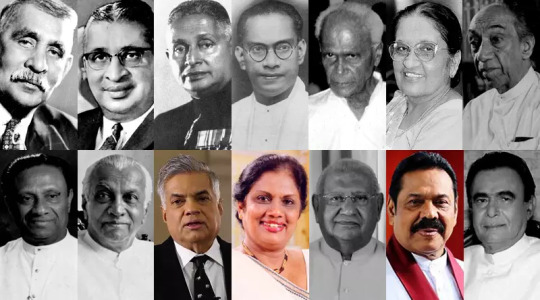
List of Sri Lankan Prime Ministers
Since this world building project is rooted in real life, the history of the world closely follows that of our own. However, this section will mainly focus on what exactly incited the "present" of the film and what that means for the future.
The Deep Past
Sri Lanka remained under colonial rule beginning from the 16th century all the way until the mid-20th. After the country gained independence in 1948, the country made a collective decision to retouch on that which they had lost during the colonial rule. Yes, the colonials brought about things that were very useful such as city and road infrastructure, the industrial revolution and valuable exports such as tea, however they did not account for the Western centric thinking that seeped into the country as a result of centuries of colonisation.
The first prime minister of Sri Lanka, Mr. D.S Senanayake, was a man who recognised this. So, he called for a nation-wide reform of these systems. This resulted in a domino effect that reformed the country of Sri Lanka as the people knew it. Education and learning were returned to a more hands-on approach, a larger focus on spirituality began as a result of reconnecting with the history and culture of the country, traditions and art were revived. In a sense, Sri Lanka was going through it's own faux-renaissance. However, it was not only art that was being developed at the time, but new technology as well. This eventually led into the avenue of renewable sources of energy.
Sustainable development had always been apart of Sri Lankan culture, which already utilised hydropower and windpower technology. It was only logical that in the early 2000s, they finally turned to solar power. However, in order to create a Solar society, the production of solar cells needed to be reliant on an almost abusive cycle of industrial production. During this time, more emphasis was placed on the common man's hard work; essentially, work and working with fellow Sri Lankan were prioritised over all else. Whoever worked the hardest reaped the most benefits.
Fast forward to the present day, the world becomes far more advanced due to the vast amounts of developments caused by a society motivated to work the hardest that they can. Income tax was collected and used for the benefit of public systems such as transport, roads, and other convenient goods and services down to the simplest of things; purchasing items at the grocery. In order to keep up this scale of development, the work had to increase. It was not uncommon to see people off to work beginning at 4.00 a.m, more common still to see those leave work at a similar time. Despite this, the people pushed themselves to their absolute limits. This is when my final film takes place, at a time where the world had almost reached a true Solarpunk future, but was being held back by its double edges ideology of hard work.
Trauma
In the real world, Sri Lanka was largely unaffected by World Wars I and II, however the country did suffer a 30 year civil war between the Sinhala Nationalists and the LTTE (Liberation Tamil Tigers of Eelam). Essentially, this was a group of people who desired independence in the North (a sect they would dub Eelam) from the rest of the country. While this world is positioned as a more idyllic version of Sri Lanka, it still suffered the same tragedies as in real life.
It was shortly after this destruction that the shift to sustainability began, due to the loss of land, money and food.
Power Shifts
The first major power shift of the country was when it gained independence from the colonials in 1948, and the heirarchy switched from a matriarch to a democratic government. It was this and the influence of sustainable Sri Lankan policies. The line up of politicians remained the same, with the difference of there being no executive presidency. The bad decisions that were made several times in the past do not occur in this universe (disadvantageous trade laws and the like), in addition to the Sinhala only act which named Sinhala as the primary language of this country. While this was one of the main catalysts of the 30 year Civil War, it was also due to underlying conflicts between the Sinhala and Tamil people.
The second was the aforementioned modern full transition to renewable sources of energy. This was a multi stage initiative funded by the Government, who recognised the tropical nature of the island climate and that it could be used to power the country for generations to come. This led to an economic and industrial boom that shot the country up the ranks of the UN's human development index. As of the time period the film takes place in, Sri Lanka is ranked among the top 10 greenest countries, the top 10 best places to retire to and the top 5 countries with the lowest carbon footprint.
0 notes
Text
My name Is Mars, I’m 18, and from America.
I come from a broken matriarchal family. Not broken BECAUSE its a matriarch, though. We just got truama by the bucket load.
I’ve always known I had a submissive nature and It was a source of shame for me for years. Especially among all the strong women in my family. I also naturallly drifted towards BDSM communities because It was the closest match to what I was feeling.
But I got seriously into christianity about seven months ago and I realized that it was EVERYTHING I was looking for and more.
At this point in my life, my goal is to heal from trauma and grow into the christian woman God is calling me to be. I’d love to make some friends on here so feel free to text me.
1 note
·
View note
Text
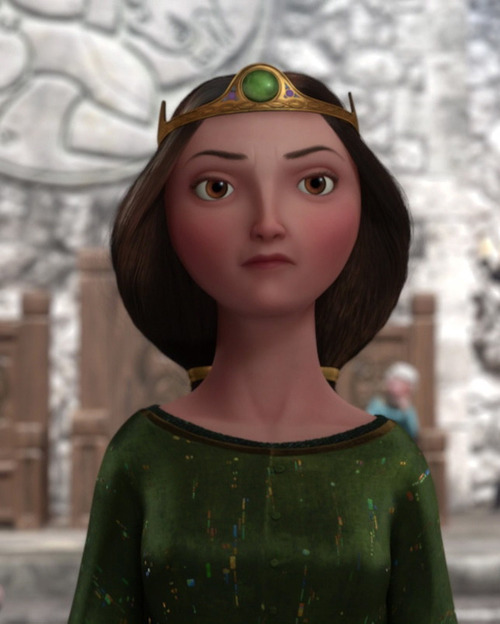
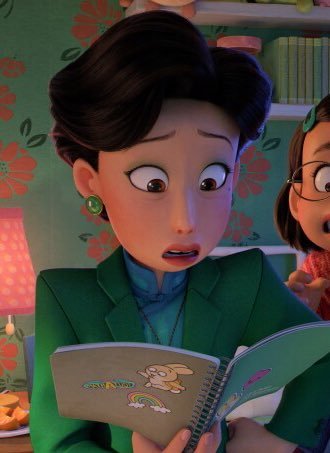
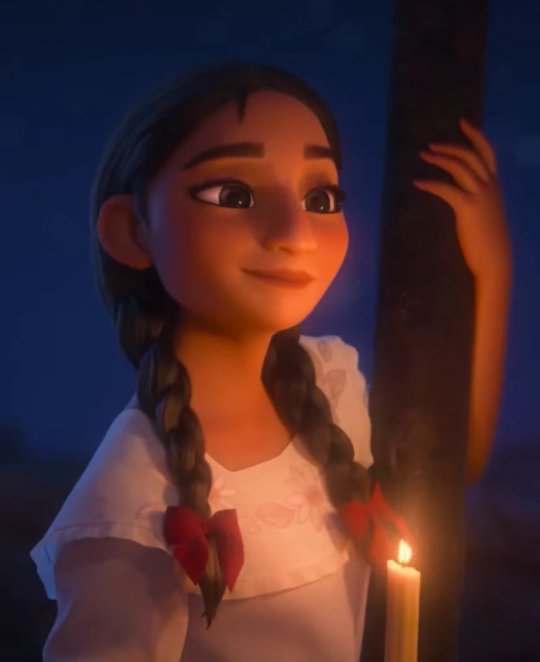

disney and pixar really said it's time to confront your mommy issues
#a matriarch and a source of trauma#brave#queen elinor#turning red#ming lee#encanto#alma madrigal#abuela#coco#imelda rivera#MOTHER GOTHEL DOES NOT BELONG HERE#the thing about the matriarchs here is that#i condone what they did#but i can't condome //them//#because this is complicated and personal#wow i need to go to therapy rather than making a tumblr post
29K notes
·
View notes
Photo




Native American Heritage Month: Fiction Picks
My Heart Is a Chainsaw by Stephen Graham Jones
In her quickly gentrifying rural lake town Jade sees recent events only her encyclopedic knowledge of horror films could have prepared her for
Jade Daniels is an angry, half-Indian outcast with an abusive father, an absent mother, and an entire town that wants nothing to do with her. She lives in her own world, a world in which protection comes from an unusual source: horror movies…especially the ones where a masked killer seeks revenge on a world that wronged them. And Jade narrates the quirky history of Proofrock as if it is one of those movies. But when blood actually starts to spill into the waters of Indian Lake, she pulls us into her dizzying, encyclopedic mind of blood and masked murderers, and predicts exactly how the plot will unfold.
Yet, even as Jade drags us into her dark fever dream, a surprising and intimate portrait emerges… a portrait of the scared and traumatized little girl beneath the Jason Voorhees mask: angry, yes, but also a girl who easily cries, fiercely loves, and desperately wants a home. A girl whose feelings are too big for her body.
My Heart Is a Chainsaw is her story, her homage to horror and revenge and triumph.
The Removed by Brandon Hobson
In the fifteen years since their teenage son, Ray-Ray, was killed in a police shooting, the Echota family has been suspended in private grief. The mother, Maria, increasingly struggles to manage the onset of Alzheimer’s in her husband, Ernest. Their adult daughter, Sonja, leads a life of solitude, punctuated only by spells of dizzying romantic obsession. And their son, Edgar, fled home long ago, turning to drugs to mute his feelings of alienation.
With the family’s annual bonfire approaching—an occasion marking both the Cherokee National Holiday and Ray-Ray’s death, and a rare moment in which they openly talk about his memory—Maria attempts to call the family together from their physical and emotional distances once more. But as the bonfire draws near, each of them feels a strange blurring of the boundary between normal life and the spirit world. Maria and Ernest take in a foster child who seems to almost miraculously keep Ernest’s mental fog at bay. Sonja becomes dangerously fixated on a man named Vin, despite—or perhaps because of—his ties to tragedy in her lifetime and lifetimes before. And in the wake of a suicide attempt, Edgar finds himself in the mysterious Darkening Land: a place between the living and the dead, where old atrocities echo.
Drawing deeply on Cherokee folklore, The Removed seamlessly blends the real and spiritual to excavate the deep reverberations of trauma—a meditation on family, grief, home, and the power of stories on both a personal and ancestral level.
The Hatak Witches by Devon A. Mihesuah
After a security guard is found dead and another wounded at the Children’s Museum of Science and History in Norman, Oklahoma, Detective Monique Blue Hawk and her partner Chris Pierson are summoned to investigate. They find no fingerprints, no footprints, and no obvious means to enter the locked building.
Monique discovers that a portion of an ancient and deformed skeleton had also been stolen from the neglected museum archives. Her uncle, the spiritual leader Leroy Bear Red Ears, concludes that the stolen remains are those of Hatak haksi, a witch and the matriarch of the Crow family, a group of shape-shifting Choctaws who plan to reestablish themselves as the powerful creatures they were when the tribe lived in Mississippi. Monique, Leroy, and Chris must stop the Crows, but to their dread, the entities have retreated to the dark and treacherous hollow in the center of Chalakwa Ranch. The murderous shape-shifters believe the enormous wild hogs, poisonous snakes, and other creatures of the hollow might form an adequate defense for Hatak haksi.
But what no one counts on is the unexpected appearance and power of the Old Ones who guard the lands of the Choctaw afterlife. Blending tribal beliefs and myths into a modern context, The Hatak Witches continues the storyline of Choctaw cosmology and cultural survival that are prominent in Devon A. Mihesuah’s award-winning novel, The Roads of My Relations.
Firekeeper's Daughter by Angeline Boulley
As a biracial, unenrolled tribal member and the product of a scandal, eighteen-year-old Daunis Fontaine has never quite fit in, both in her hometown and on the nearby Ojibwe reservation. Daunis dreams of studying medicine, but when her family is struck by tragedy, she puts her future on hold to care for her fragile mother.
The only bright spot is meeting Jamie, the charming new recruit on her brother Levi’s hockey team. Yet even as Daunis falls for Jamie, certain details don’t add up and she senses the dashing hockey star is hiding something. Everything comes to light when Daunis witnesses a shocking murder, thrusting her into the heart of a criminal investigation.
Reluctantly, Daunis agrees to go undercover, but secretly pursues her own investigation, tracking down the criminals with her knowledge of chemistry and traditional medicine. But the deceptions—and deaths—keep piling up and soon the threat strikes too close to home.
Now, Daunis must learn what it means to be a strong Anishinaabe kwe (Ojibwe woman) and how far she'll go to protect her community, even if it tears apart the only world she’s ever known.
#Fiction#mystery#mysteries#thrillers#horror#to read#tbr#books to read#Book Recommendations#reading recommendations#Native American Heritage Month#NAHM#library books#new books#booklr#book tumblr#books to check out
87 notes
·
View notes
Text
I just watched turning red. incredible that in the span of 4 months di$ney gave us two glasses wearing teenage protags with generational trauma surrounding magic and had the source of the MC's trauma (the matriarch of their families) take accountability and apologize at the end
18 notes
·
View notes